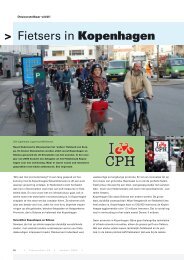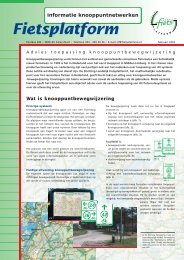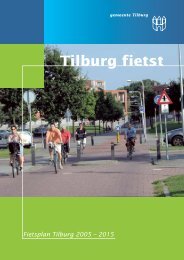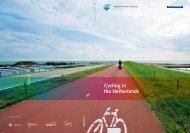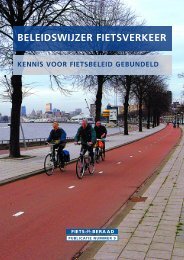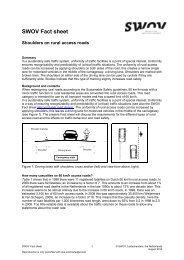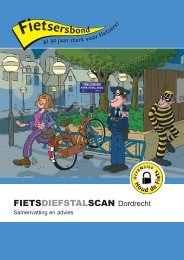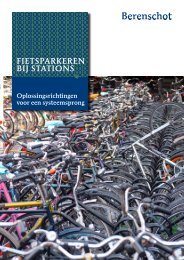Beleving en beeldvorming van mobiliteit - Kennisinstituut voor ...
Beleving en beeldvorming van mobiliteit - Kennisinstituut voor ...
Beleving en beeldvorming van mobiliteit - Kennisinstituut voor ...
You also want an ePaper? Increase the reach of your titles
YUMPU automatically turns print PDFs into web optimized ePapers that Google loves.
To answer these questions, a survey was conducted in the spring of<br />
2005 as a joint initiative of the Directorate-G<strong>en</strong>eral of Public Works<br />
and Water Managem<strong>en</strong>t Transport Research C<strong>en</strong>tre (RWS-AVV)<br />
and The Netherlands Institute for Social Research (SCP). The writt<strong>en</strong><br />
questionnaire was distributed among a repres<strong>en</strong>tative sample of the<br />
adult Dutch population (aged 18 and over), and produced 1,028 usable<br />
responses.<br />
Cars and bicycles most preferred, public transport least popular<br />
The study showed that travelling by car is considered the most attractive<br />
mode of transport by two-thirds of all people in the Netherlands (67%),<br />
roughly one quarter prefer to cycle (27%) and 4% find public transport<br />
the most appealing.<br />
In g<strong>en</strong>eral, people in the Netherlands give a positive rating to the<br />
mode of transport they use the most and treat alternatives with more<br />
scepticism.<br />
In other words, the more oft<strong>en</strong> people use a particular mode of<br />
transport, the more positively they perceive it. This is particularly<br />
true of public transport. Of the people who rarely/never take public<br />
transport, 62% hold a negative view of it, whereas the majority of<br />
people who take public transport several times a week experi<strong>en</strong>ce it<br />
positively (56%). However, nearly one quarter (24%) of these ‘frequ<strong>en</strong>t<br />
users’ assess public transport negatively. By comparison, the number<br />
of motorists/cyclists with a negative view of their respective form of<br />
transport is very small (3% and 1%, respectively).<br />
People in the Netherlands also associate positive feelings with travel by<br />
car and bicycle. Travelling by car is associated with pleasure by 52%<br />
of the population, and travelling by bicycle by 67%. Far fewer people<br />
associate negative emotions with cars and bicycles. Approximately 6%<br />
of the population associate cars with negative feelings, and 4% perceive<br />
travelling by bicycle negatively. Public transport is associated with<br />
pleasure by 11% of the population, whereas one in five people in the<br />
Netherlands have feelings of aversion towards it.<br />
Aspects of travel account for differ<strong>en</strong>ces in appeal<br />
Differ<strong>en</strong>ces in the appeal of travel by car, bicycle and public transport<br />
can be partially explained by aspects of travel, including speed, cost,<br />
comfort and other aspects such as indep<strong>en</strong>d<strong>en</strong>ce and flexibility.<br />
Travelling by car offers far more conv<strong>en</strong>i<strong>en</strong>ce, indep<strong>en</strong>d<strong>en</strong>ce, flexibility,<br />
comfort, pleasure, safety and speed than travelling by public transport.<br />
People have a predominantly positive view of travelling by bicycle – in<br />
12 <strong>Beleving</strong> <strong>en</strong> <strong>beeldvorming</strong> <strong>van</strong> <strong>mobiliteit</strong>


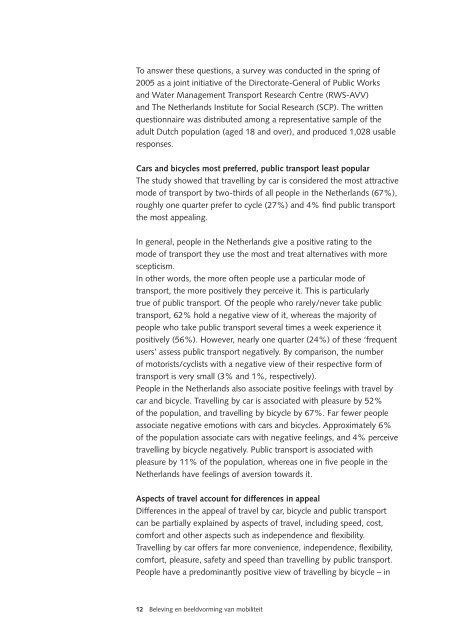
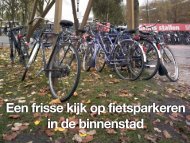
![[plein] - Fietsberaad](https://img.yumpu.com/20829245/1/184x260/plein-fietsberaad.jpg?quality=85)
